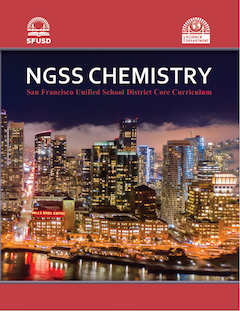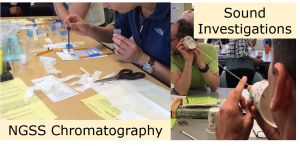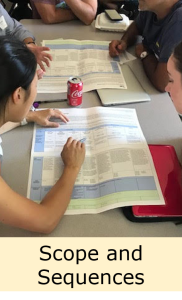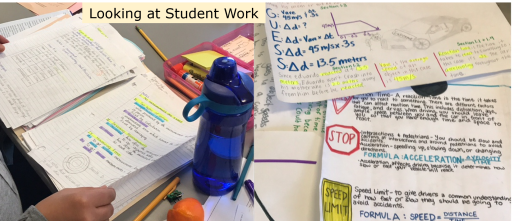About the HS Science curriculum Link to this section
This page is intended for individuals that are not affiliated with SFUSD. If you are a member of the SFUSD community, you should visit either the Students and Families page or the general HS Science page to gain more information and access to the curriculum.
SFUSD High School Scope & Sequence
If you have not yet taken a look, please check out our SFUSD HS Science Scope & Sequences. The Earth & Space Science and Engineering NGSS Standards are threaded throughout each of the SFUSD Scope and Sequences. These were designed by SFUSD teachers and used to create each of our Core Curriculum courses. You will find that these differ slightly from the CA State Framework, as they were developed prior to its release. The Scope and Sequences will give you an overview of the year’s flow for each course.
To learn more about implementation in SFUSD, you might want to look at our About HS Science page.
Learn more about our path to implementing a Core Curriculum and work with teachers.
Curriculum
All of our curriculum is based on our Scope and Sequences and uses the 5E model. We have developed our own NGSS Chemistry course which is available to all. We worked with publishers to adapt their materials for our NGSS Biology and NGSS Physics courses. Please click on the links below to access documents that show which chapters we are using. Note that we often modified chapters and sections, but we are cannot provide that level of detail here.
- NGSS Biology - Adapted from BSCS Biology: A Human Approach
- NGSS Physics (both 9-10 and 10-12) - Adapted from Active Physics + Earth Comm
- NGSS Chemistry - Developed by SFUSD + available to the public
Sample Activities
Before developing our Core Curriculum, SFUSD teachers created several learning experiences based on the 5E model. Those are available at http://tinyurl.com/SFUSD-CLEs. Because they were developed prior to implementing a Core Curriculum, these may have been integrated into the Core curriculum or different activities were chosen to better suit the scope and sequences.

We are excited to offer access to our year-long NGSS Chemistry curriculum.
SFUSD HS Science Path to Implementation
Link to this section
Pre-Core Curriculum (<2016)
SFUSD is one of the 100 largest school districts in the United States (50-60,000 students). The population is diverse and over half the students are socioeconomically challenged. You can see more information about the district in the "Facts At a Glance" page.
- Pre- NGSS: Every high school in the district could choose what to offer their students in 9th grade. And not all 9th grade students took science. Some schools had students in science courses that did not meet graduation requirements and were not classified as "d" science course for UC A-G requirements. This meant that not all students were being equitably supported. Additionally, most high schools did not have consistency within courses. Teachers of the same subject could choose what to teach, and in what order. This meant that one student's experience could be drastically different from another's, even within the same school.
The school district also did not provide materials for science. This meant that each science department at a school depended on their school site giving them funding to purchase materials. This resulted in large disparities between school sites with more funding and those with smaller budgets. This then led to teachers having to spend their own money on supplies or a poorly supported classroom. - 2013-14 - Learning about NGSS: During this year, secondary teachers (MS and HS) met for multiple full day PDs to learn more about the new standards and shifts that would be required to implement the NGSS.

- 2014-15- Scope and Sequence: During this year, secondary teachers (MS and HS) worked to develop scope and sequences for middle school and 3 high school courses (Biology, Chemistry and Physics). At the high school level it was decided that 9th grade students would take either Biology or Physics, dependent on the school's choice. For a single site, all 9th grade students would be in the same course, to avoid student tracking.

- 2015-16- Development of CLEs: During this year, secondary (MS and HS) worked to develop common learning experiences (CLEs). The goal was to develop 4 experiences that would be spaced out during the year. This was meant to address differences between teachers, to help make sure students could meet the standards. After teachers tested out the common experiences and the results were analyzed, we determined that the experiences were extremely dependent on what the teacher had implemented prior. Since each teacher could determine their own order of topics and when to implement the CLE, student outcomes varied widely. Therefore, the teachers and the science department decided to implement a year long Core Curriculum to help provide students with consistent learning and to support teachers with implementing NGSS.
Development of Core Curriculum (2016-2022)
- 2016-17- Development of Curriculum: At the beginning of the year, teachers evaluated various existing 5E curricula for each of the subject areas, to determine which best matched the Scope and Sequences and the NGSS standards. For Biology, BSCS's "A Human Approach" was chosen and for Physics, a combination of Active Physics and Earth Comm. In Chemistry, there was not an existing 5E curriculum that matched the scope and sequence sufficiently. Therefore, a decision was made to create our own Chemistry curriculum. During this year, teachers worked to adapt the Biology and Physics curriculum for 9th grade implementation. Chemistry teachers worked on creating unit/chapter flows based on the scope and sequence.
- 2017-18- Implementation of Core Curriculum: All 9th grade students started this year in either NGSS Biology or Principles of NGSS Physics. Additionally, all teachers of core curriculum were provided with the lab materials necessary to teach the core curriculum. 10-12 students remained in pre-NGSS courses. Throughout the year HS teachers regularly gave feedback on the Biology and Physics Core Curriculum. This allowed for revisions and changes to be made. A year long NGSS Chemistry course was developed during this year.
- 2018-19- Further Implementation of Core Curriculum: Following revisions based on feedback from teachers, a new version of the 9th grade curriculum was implemented and NGSS Biology and NGSS Physics were implemented in grades 10-12. Again, all necessary supplies were provided and consumables were replenished for 9th grade teachers. NGSS Chemistry was field tested by 9 teachers from across the district and their feedback was used to make revisions to the Core Curriculum.

- 2019-20- Full Implementation of Core Curriculum: NGSS Chemistry was implemented across the district as were revised Biology and Physics books. All needed materials were supplied to school sites.
- 2020-22- Finalizing the Core Curriculum: Over the course of 2 years, all Core Curriculum was finalized, based on feedback and experiences of teachers and students. Hardback books were delivered to school sites for long-term use. Additionally, we finalized teacher editions and supports for each course.

Supporting Teachers with Implementation (2016-2022)
To support implementation, the first two years for each course had a variety of professional development (PD) for teachers.
First, a 4 day institute was offered before the school year started. Teachers experienced the first chapter as students, then explored the remainder of fall semester in a jigsaw. The institute also included 1 day of planning time. Following this, there were 3 Collaboration days during the year. Two of them focused on teachers exchanging their experiences and learning from each other, through activities such as "look at student work" and video reflections. The 3rd day supported teachers learning about the spring semester of the curriculum.

In year 2, teachers continued the collaboration with 2 collaboration days during the year. Again they shared their experiences and student work.

This page was last updated on June 2, 2023

